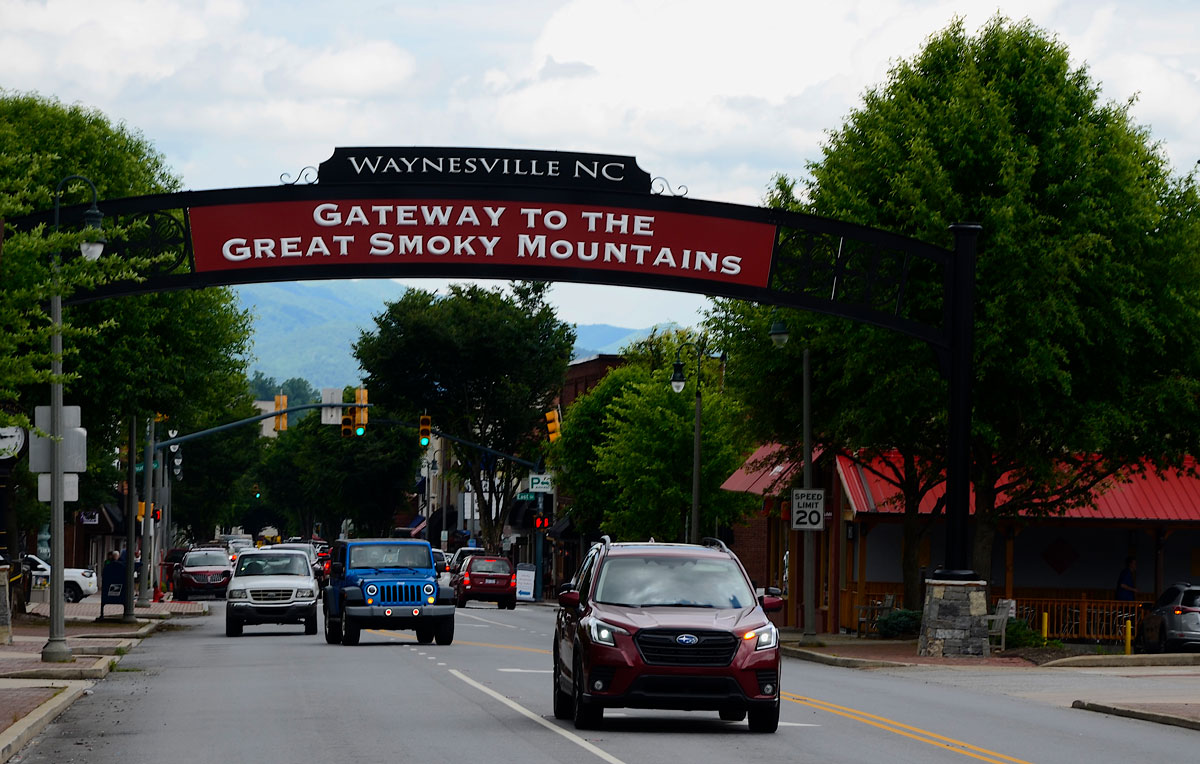
The air buzzed with excitement as the crowd gathered in downtown Waynesville, North Carolina, on Saturday, June 1. A standing-room-only assembly packed the street and sidewalk for a solid block between First Baptist Church and town hall, necks turned upward toward the new steel arch—still shrouded in black cloth—spanning Main Street.
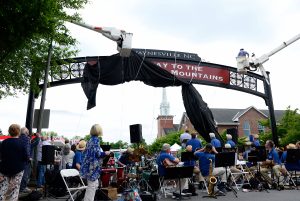
Bucket trucks manned by town electric workers stood at the ready, and when, at the conclusion of a celebratory speaking program, they cut the zip ties holding the cloth in place, a great cheer rose from the audience. A band began to play as the words beneath were revealed, decorative outlines of dogwood blooms sculpted on either side: “Waynesville NC, Gateway to the Great Smoky Mountains.”
“Today, we’re celebrating more than just the unveiling of the new ‘Gateway to the Great Smoky Mountains’ arch,” said Waynesville Town Council member Jon Feichter. “We’re here to celebrate the power of determination, best illustrated in the old adage, ‘Where there’s a will, there’s a way.’”
The new arch resurrects a downtown landmark that many longtime residents still remember fondly. Anticipating the creation of Great Smoky Mountains National Park, which would occur through an act of Congress in 1934, the town completed installation of the original arch on May 31, 1933. Spanning Main Street at its intersection with Depot Street—the opposite end of downtown from the new arch—the sign was made of steel and sheet iron, bearing the words “The Great Smoky Mountains National Park,” with a second sign hanging below, shaped like an arrow, reading “Eastern Entrance.” According to a June 1, 1933, article in The Mountaineer newspaper, the massive sign, together with its supports, weighed about two tons. It was painted later that month with a black background and white lettering, the paper reported.
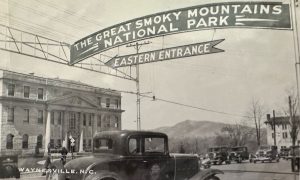
Though it was repainted in the late 1950s—with new wording, “Waynesville, Scenic Center Eastern North America,” in response to sentiment from other towns in the region that no one community should claim the “eastern entrance” title—the sign remained an icon for decades, integral to the identity of an ever-changing downtown. Though the wording changed, “at all times it has given a word-picture of the area,” read a July 19, 1972, Mountaineer editorial.
“When you are a little girl, and all your ancestors on both sides of your family are short, and they married other short people, the only way you have to see anything at all is to look up,” Sara Scruggs said at the ceremony, reading from an essay she wrote about the arch’s significance in her life. “So, when I looked up, I saw the arch, and the arch was over the mountains, because I was so short. I saw that the mountains went on forever—the light and the dark, the shadows, all woven together with our hopes and our dreams, our secrets and our fears, that the mountains hold in trust for all of us.”
When the family returned home from sojourns to visit relatives to the east, that first glimpse of the arch would mark their official homecoming.
But then, on Aug. 31, 1972, town crews took the sign down. Most people were sorry to see it go—a survey the chamber of commerce conducted beforehand drew 132 responses, with 83 percent hoping to see the sign stay, The Mountaineer reported. But the sign, rusted and weatherworn from decades presiding over the town’s main thoroughfare, was disintegrating. Regardless of whether Main Street continued to have an arch, this one would have to come down.
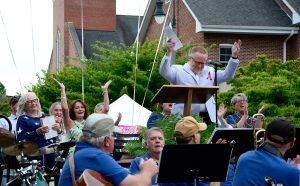
“Now that it’s down and we can see how Main St. looks without it we should conduct another poll to see whether the people really want it,” Town Manager Bill Ross is quoted as saying in a Sept. 1, 1972, Mountaineer article. “And tell anybody who wants it put back up to send us a dollar to help pay for it. If we’re going to have a sign, we’re going to have to build another one.”
From the beginning, the sign’s presence had relied on residents’ willingness to “send a dollar.” The original sign cost $250—more than $6,000 in today’s dollars—of which only $50 came from town coffers, according to a history of the sign compiled by the Downtown Waynesville Association. The rest was raised through a benefit movie shown that spring. In keeping with that tradition, the new sign was funded entirely through donations. The DWA contributed $60,000 of the $185,000 cost and worked to raise the remaining $125,000.
Some of the money came through direct donations, and some was raised through more innovative means. Waynesville artist and DWA board member Teresa Pennington, who is known for her incredibly detailed colored penciled drawings, created a piece aptly titled “Gateway Arch” that shows the new arch in its place on Main Street. Proceeds from sales went toward the arch effort. Smokies Life gave Pennington table space at its annual Members Weekend event in September to sell raffle tickets for the drawing, and Friends of the Smokies did the same at its Smokies Stomp last year.
“If you don’t remember anything else that I have said, please remember that this is a gift,” Pennington said at the ceremony. “There was no taxpayer money spent on this arch or in putting the arch up, because we wanted to give it to the town, ourselves, and to all of you. This is a gift for everybody.”
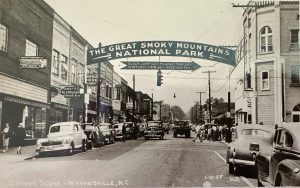
In the years since the arch’s removal, Waynesville has seen its share of hard times. Former DWA Director Buffy Phillips recalled how in 1986, when the organization first formed, 23 percent of downtown buildings were vacant. The town has grown and changed since then, welcoming ever-increasing numbers of Smokies visitors. In 2023, the park’s North Carolina entrances drew 3.3 million visits, up from 2.7 million in 1995. According to a study from the National Park Service, in 2022 visitors spent a total of $2.1 billion in Great Smoky Mountains National Park gateway communities such as Waynesville.
Pennington was a small child when the arch came down in 1972, so she doesn’t remember the original structure. But what she does remember, “vividly,” is Sunday afternoons spent picnicking in the park, camping trips “in Smokemont with the bears,” and summers in Cades Cove “with more bears.” The skunks left an even stronger impression—Pennington can recall how she’d sit “perfectly still” around the campfire when one of those striped creatures came around.
Downtown Waynesville and the national park have been formative forces in Pennington’s life, just as they have been for many others who attended the unveiling.
“We’re here today to celebrate both,” she said, “the historic arch that’s before you in the downtown that has been rescued by an organization that has served this community for 38 years and the Great Smoky Mountains National Park that was opened in 1934. And aren’t we all so grateful that that area has been preserved?”
Subscribe to get the latest posts sent to your email.
The Great Smokies Welcome Center is located on U.S. 321 in Townsend, TN, 2 miles from the west entrance to Great Smoky Mountains National Park. Visitors can get information about things to see and do in and around the national park and shop from a wide selection of books, gifts, and other Smokies merchandise. Daily, weekly, and annual parking tags for the national park are also available.